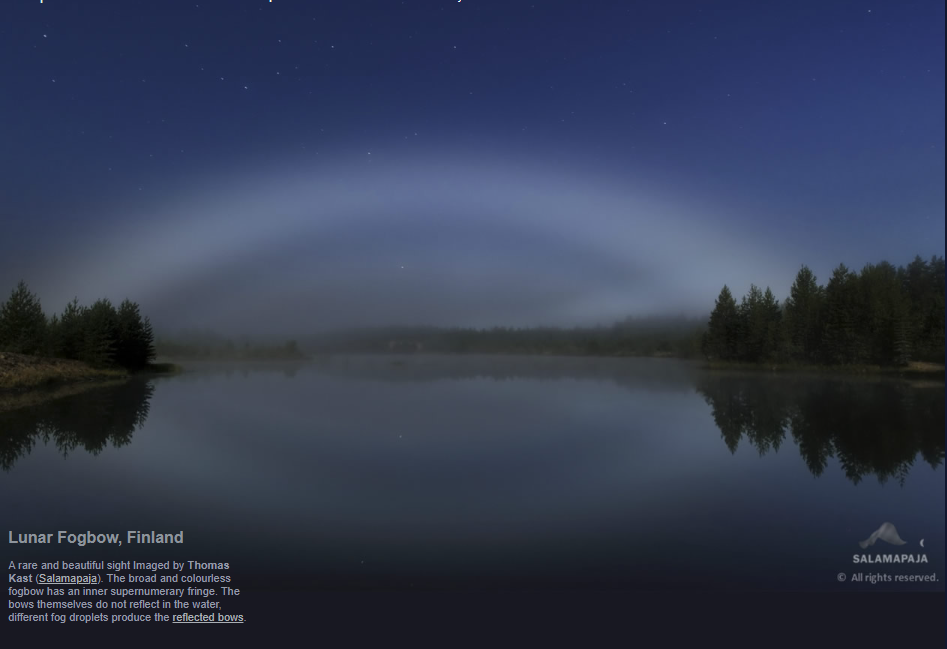Lunar Fogbow, Finland - OPOD
Lunar Fogbow: A Rare and Enchanting Atmospheric Phenomenon
Have you ever heard of a lunar fogbow? It's a fascinating and captivating optical phenomenon that occurs under specific atmospheric conditions. While rainbows are commonly seen after rain showers, fogbows are a more elusive sight. In this article, we'll explore the magical world of lunar fogbows, with a focus on a particular sighting in Finland captured by Thomas Kast.
The Beauty of the Lunar Fogbow in Finland
The image captured by Thomas Kast in Finland showcases the ethereal beauty of a lunar fogbow. Unlike rainbows, which are characterized by vibrant colors, fogbows appear broad and colorless. However, upon closer inspection, you can observe an inner supernumerary fringe within the fogbow. Interestingly, the bows themselves do not reflect in the water, as different fog droplets produce the reflected bows.
Understanding the Science Behind Lunar Fogbows
To comprehend the science behind lunar fogbows, we need to delve into the properties of fog droplets. These tiny droplets typically range from 1 to 100 microns in diameter, making them significantly smaller than raindrops. The size of these droplets is crucial because they are close enough to visible light wavelengths (0.4 to 0.7 microns) for diffraction effects to come into play.
Due to diffraction, lunar fogbows appear diffuse and faint, lacking the sharp and vibrant hues of rainbows formed by larger raindrops. Each fog droplet acts as a reflector and diffracts incoming plane waves backward, contributing to the formation of the fogbow rings. Additionally, waves scatter in various directions, resulting in the simultaneous appearance of other optical phenomena such as glories and coronas.
A Closer Look at Fogbow Formation
When it comes to fogbows, the process of formation is similar to that of rainbows. However, the main distinction lies in the size and properties of the droplets involved. Let's take a closer look at the steps involved in fogbow formation:
- Droplet Suspension: Fog droplets are suspended in the air, creating a misty atmosphere.
- Sunlight or Moonlight Interaction: Sunlight or moonlight interacts with the suspended droplets.
- Refraction: The incident light refracts as it enters the droplets.
- Reflection and Diffraction: Within each droplet, the light reflects and diffracts, creating a range of angles for scattered light.
- Interference: The diffracted light waves interfere constructively and destructively, resulting in the fogbow's characteristic rings.
The Intriguing Glory and Corona
In addition to fogbows, other optical phenomena can often be observed simultaneously. One such phenomenon is the glory, which appears as a set of colored rings surrounding the observer's shadow. The glory is caused by diffraction and interference of light waves within tiny water droplets or fog droplets.
Another phenomenon that may accompany fogbows is the corona, which appears as a series of concentric colored rings encircling the sun or moon. Coronas are formed when light waves are diffracted and interfere with each other due to the diffraction properties of the droplets.
Conclusion: A Spectacular Sight Worth Seeking
Lunar fogbows are a captivating natural phenomenon that offers a glimpse into the wonders of atmospheric optics. The sighting captured by Thomas Kast in Finland serves as a testament to the enchanting beauty that can be found in nature. Understanding the science behind fogbows allows us to appreciate the intricate processes involved in their formation. So, keep your eyes peeled during misty nights or foggy mornings – you might just catch a glimpse of a lunar fogbow, a rare and mesmerizing spectacle in the sky.

Lunar Fogbow, Finland
A rare and beautiful sight Imaged by Thomas Kast (Salamapaja). The broad and colourless fogbow has an inner supernumerary fringe. The bows themselves do not reflect in the water, different fog droplets produce the reflected bows.

Fog droplets are small (1-100 micron diameter). They are sufficiently close to visible light wavelengths (0.4-0.7 micron) that diffraction effects are significant.
The result is a diffuse and wan bow rather than the sharp bright hued rainbow from much larger raindrops.

Each droplet reflects and diffracts incoming plane waves backwards to form the fogbow rings.
Waves scatter in other directions to simultaneously form the glory and corona.
Note: this article has been automatically converted from the old site and may not appear as intended. You can find the original article here.
Reference Atmospheric Optics
If you use any of the definitions, information, or data presented on Atmospheric Optics, please copy the link or reference below to properly credit us as the reference source. Thank you!
-
<a href="https://atoptics.co.uk/blog/lunar-fogbow-finland-opod/">Lunar Fogbow, Finland - OPOD</a>
-
"Lunar Fogbow, Finland - OPOD". Atmospheric Optics. Accessed on November 26, 2024. https://atoptics.co.uk/blog/lunar-fogbow-finland-opod/.
-
"Lunar Fogbow, Finland - OPOD". Atmospheric Optics, https://atoptics.co.uk/blog/lunar-fogbow-finland-opod/. Accessed 26 November, 2024
-
Lunar Fogbow, Finland - OPOD. Atmospheric Optics. Retrieved from https://atoptics.co.uk/blog/lunar-fogbow-finland-opod/.